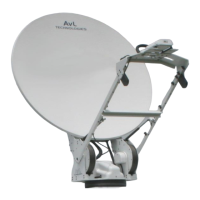AvL Proprietary and Confidential
Content is Subject to Change without Notice Page 158 of 195
The second type of reference satellite uses a “DvB” carrier on a known satellite location and of a
known frequency, bandwidth etc. While this offers a generally lower power carrier than the DBS
type, the specifics of the carrier make it very unlikely that an adjacent satellite will be acquired.
Use of a Reference Satellite requires the creation of a separate profile for each Reference chosen.
The Reference is then set to use the signaling device and carrier information available. An example
of a reference profile created to use the AvL DvB receiver can be found in section 5.9.9 of this
manual as well as section 9.6 of the DvB receiver appendix.
7.4.4 Pedestal Tilt Compensation
In order to calculate an accurate satellite pointing solution, the tilt (pitch and roll) of the antenna
platform must be known to a relatively high degree of accuracy. This information also plays an
important part in aligning the antenna’s linear polarization vector with that of the target satellite to
insure optimal co-polarized signal transmission / reception and to minimize cross-polarized
interference on the forward and return links.
Tilt of the antenna platform is measured by precision inclinometers that are usually located inside
the AAQ ACU main module. The ACU module is typically mounted directly on the Azimuth
positioner base plate above the Azimuth Bearing Assembly. Mounted in this location, the sensors
are always on a surface that is nominally level during antenna operation, which insures the actual tilt
of the system will be well within the accurate / linear range of these devices.
During normal operation, pitch and roll sensor values are recorded during the Home process (for
calculation of the pointing solution) and immediately after peaking is completed on the target
satellite (for polarization optimization).
7.4.5 Satellite Pointing Solution
The AAQ calculates the current pointing vector of the reflector boresight in Pedestal Coordinates
and World (Local Tangent Plane) Coordinates. These are displayed on the AAQRemote GUI main
window and output as Sensor Outputs if desired.
World Coordinates - These are the AZ/EL spherical coordinates in the Local Tangent Plane
reference system. AZ is measured clockwise (when looking down on the antenna) from true
north. EL is measured up from the local tangent plane (horizon). These are the coordinates
most common in the satellite industry.

